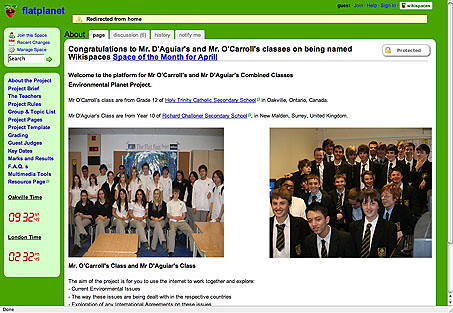 If there was ever a doubt that the tools of Web 2.o are dramatically simplifying the way we can embed digital technologies into our classrooms, let me point you towards a neat little project run by a couple of amazing teachers who decided to dabble with the possibilities of a wiki. This wonderful piece of web collaboration was put together by Neil D’Aguiar from Richard Challoner Secondary School in New Maiden, Surrey, UK, and Simon O’Carroll from Holy Trinity Catholic High School in Oakville, Ontario, Canada. It’s a great example of how something as simple as a wiki can be used to develop a sophisticated web project that works simply and easily across the boundaries of time and place. The site can be found at flatplanet.wikispaces.com.
If there was ever a doubt that the tools of Web 2.o are dramatically simplifying the way we can embed digital technologies into our classrooms, let me point you towards a neat little project run by a couple of amazing teachers who decided to dabble with the possibilities of a wiki. This wonderful piece of web collaboration was put together by Neil D’Aguiar from Richard Challoner Secondary School in New Maiden, Surrey, UK, and Simon O’Carroll from Holy Trinity Catholic High School in Oakville, Ontario, Canada. It’s a great example of how something as simple as a wiki can be used to develop a sophisticated web project that works simply and easily across the boundaries of time and place. The site can be found at flatplanet.wikispaces.com.
I first met Simon when I was on a teacher exchange to Canada during 2006. We shared a workroom (and occasionally chicken wings) and became quite good mates. As a teacher of Religion, Simon was a relative newbie to the integration of technology into his classroom, but during the year he enrolled into a part-time Computers in the Classroom course. Each day after his course he would come and have a chat to me and ask questions about web technologies, and I really enjoyed our talks. It was fun to watch him get more and more fired up about the uses of ICT in his classroom, and in particular the things that Web 2.0 was making possible. We spoke about blogs and wikis, podcasting and social networking. Simon started to blog regularly, and still has a nice little blog happening at http://mrocarroll.wordpress.com/. He played with a number of different blog engines like WordPress and Blogger. Then he started to investigate wikis, playing with Wikispaces and PBwiki. He’d come into work each day and tell me about some new discovery he’d made on the web, or ask for my opinion about some new technology. It was really exciting to see the web through his eyes.
Not long after I got back to Australia, Simon wrote to me to tell me about the Flat Planet Project that he started with Neil from the UK. It’s humbling to realise just how easy it can be to start a project like this, because it is was simple as just making contact and asking for a partner, as he did with Neil. It’s such a beautifully simple idea… connect two sets of students from two schools in two countries, give them a common task and provide them with the tools to work across the web. No wonder the site was chosen as the Wikispace of the Month for April! As I look through the pages they have created, you can just tell what a great job the kids did, and from all accounts they thoroughly enjoyed working on it. You can see the positive benefits of this collaboration, and just how much more meaningful this task was because of its authenticity. This is what the new web makes possible!
I wanted to highlight the work done by the kids at Challoner and Trinity, and the great work done by Simon and Neil in leading the kids through this project. Education can be stiflingly conservative at times, so it’s wonderful to see teachers stepping out of their comfort zones and extending both themselves and their kids with projects like this. Good on you Simon, Neil and all the kids who took part!
I’m hoping to interview Simon and Neil very soon on The Virtual Staffroom Podcast, so keep that RSS feed tuned in!
